Over the next several months, the WLA Blog will feature posts written by guest writers. These writers are graduate students in the Public History program at Loyola University Chicago. Each visited the archives during Fall 2021, delved into the collections, and wrote about a topic not yet explored here. We are excited to share their research and perspectives!
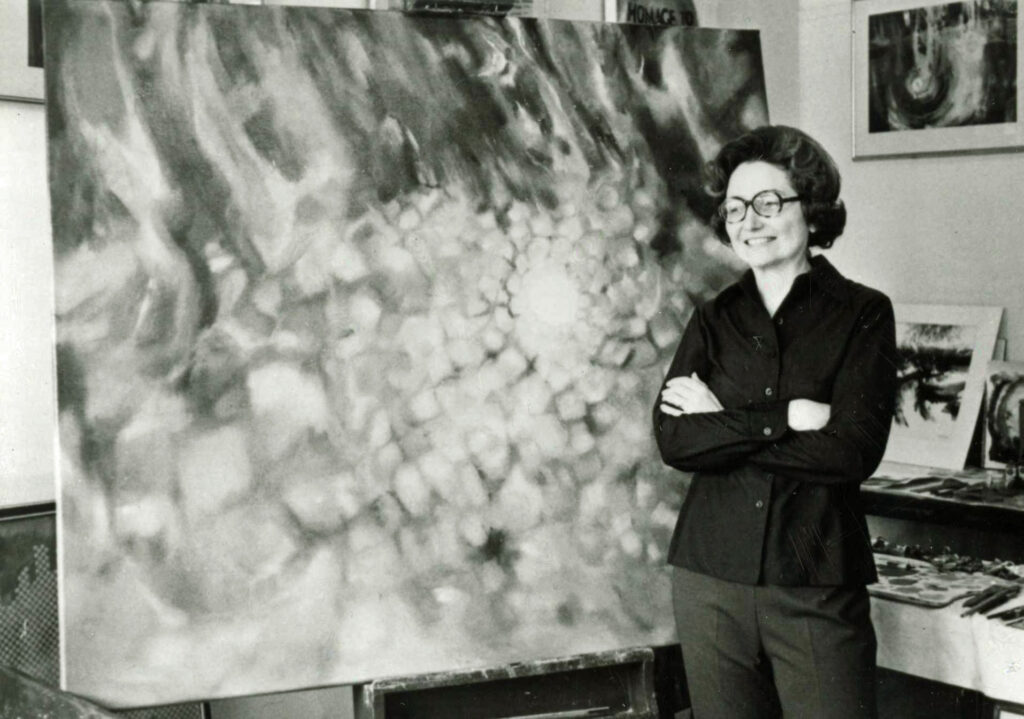
Sr. Blanche Marie at her Chicago studio next to her artwork, “Homage to Teilhard: Planetization.”
In mid-twentieth-century America, it would have been reasonable to expect a young middle-class woman to graduate from high school, maybe attend college, find a handsome veteran to marry, and raise a family of Boomers. For Patricia Gallagher, this is precisely the path she envisaged for herself – a motion-picture-perfect life as personified by Ginger Rogers and Kathryn Hepburn [i]. However, a series of serendipitous turning points took Gallagher on a much different and unexpected journey.
Born in 1922, Patricia Mary Jane Gallagher grew up in Waverly, Iowa. She was the youngest of five children, and, as the only daughter, she “had been able to maneuver” her father from day one [ii]. Patricia’s childhood virtuosity for music prompted a scholarship offer from the State University of Iowa, where her friends were enrolling. However, Patricia’s plan was dashed when her father, in a rare moment of resistance to her charming maneuvers, insisted that he “had to send his children to Catholic colleges under pain of sin” [iii].
Patricia begrudgingly began her university career at Clarke College in Dubuque, Iowa. However, she would not give her father the satisfaction of becoming a music major after he forced her to abandon her state-university scholarship. Instead, she randomly selected Interior Design from the course catalog but found herself mistakenly enrolled on the first day as an art major [iv]. This accident of fate was just the beginning of Gallagher’s life-long relationship with art.
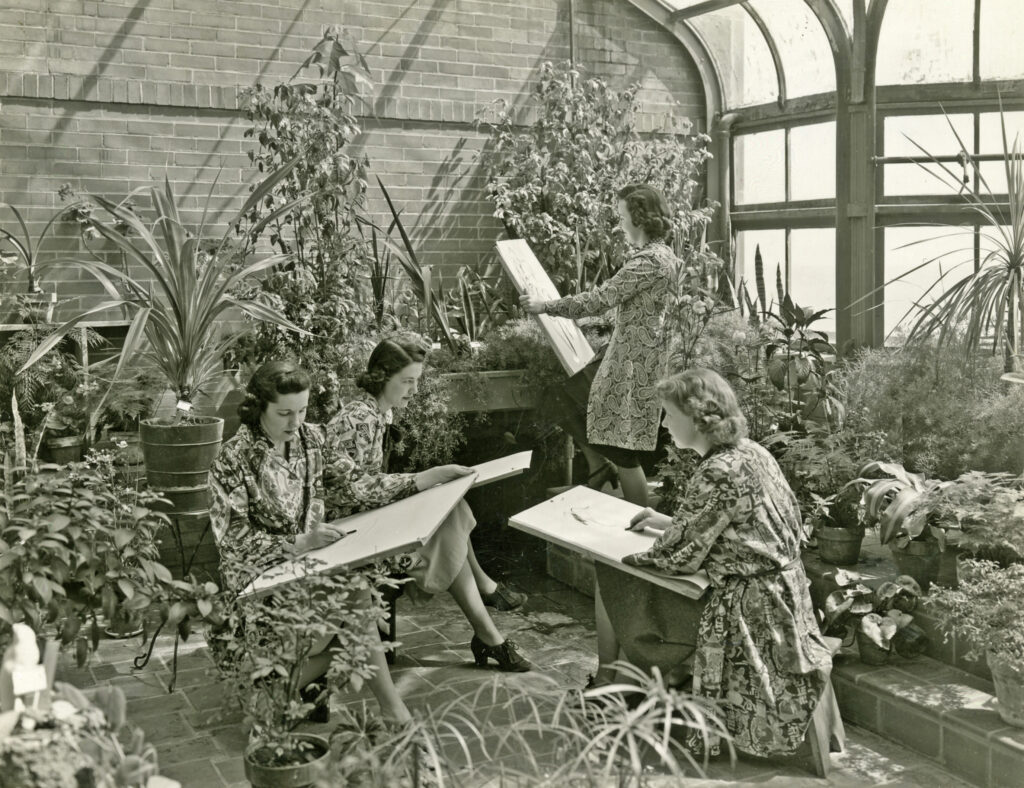
A photograph of the skyscraper building’s 13th floor studio space depicts how the art department likely appeared to Patricia Gallagher in 1942.
Two years at Clarke were two too many. Patricia detested the strict Catholic disciplinary code and desperately wanted to escape Iowa [v]. After soliciting information from other institutions, Patricia applied to Mundelein College “because of the picture of the building on the catalog cover, and because it was in Chicago” [vi]. In 1942, her parents moved her into the 13th floor of the Art Deco skyscraper building on Sheridan Road.
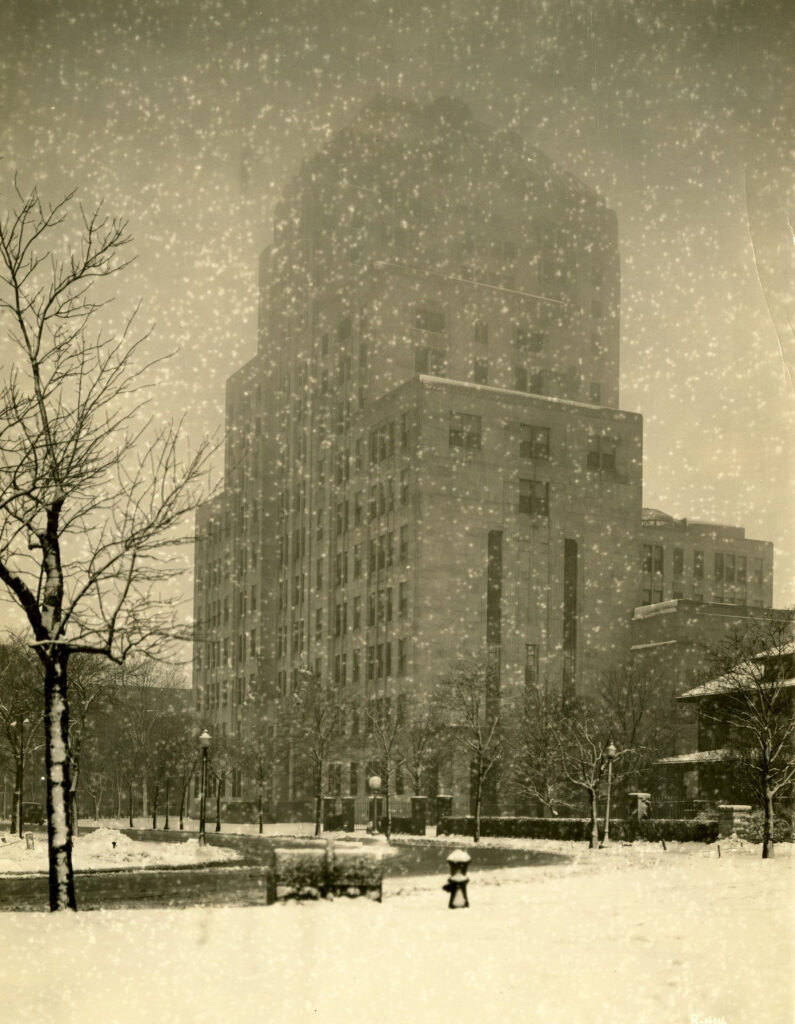
The skyscraper building’s impressive façade attracted Gallagher to Mundelein College.
For $150 a year, Patricia joined 620 female students enrolled at Mundelein College. Like many young women of that era, she rallied home-front support for the war, drew stocking “seams” on her legs, danced with Loyola men in the gymnasium, drank Brandy Alexanders at the Yacht Club, smoked Menthol Kools, and worked a part-time gig at Marshall Field’s [vii]. During classes, the students were groomed “to become wives of men of consequence,” and Patricia was on track to fulfill her motion-picture fantasy marriage [viii].
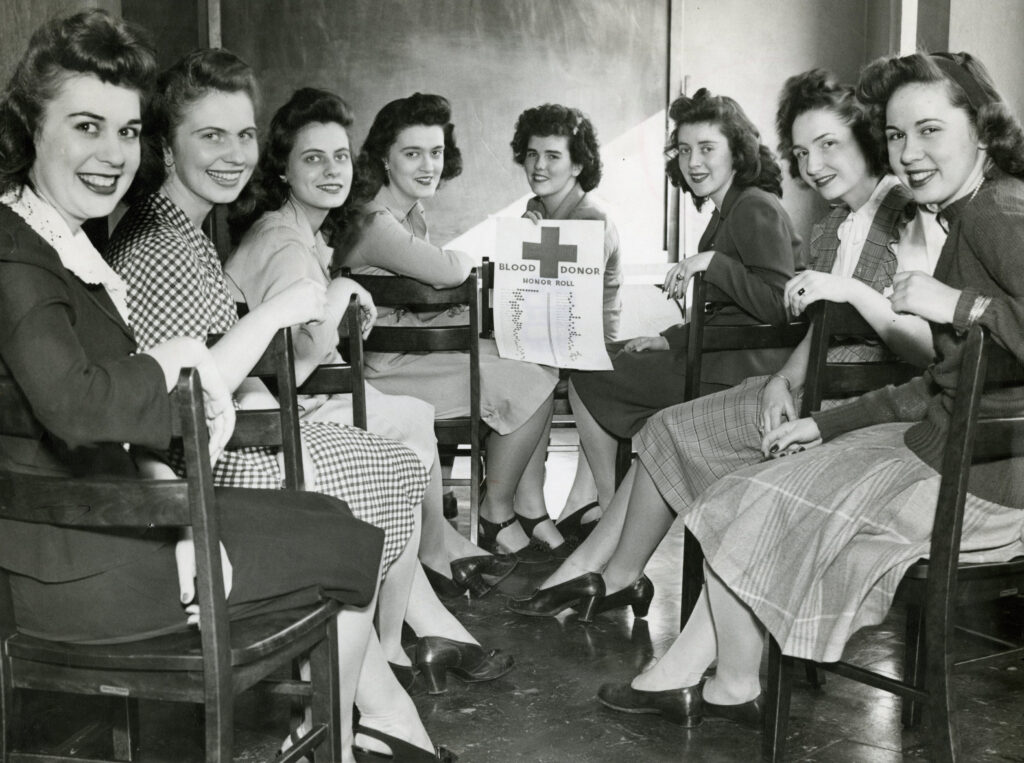
As World Warr II roiled overseas, Mundelein students on the home front supported the war effort through blood donations. (Patricia Gallagher is seated second from the right.)
On a February night in 1946, Patricia awoke to a Presence. “It was a voice, a knowing, nothing that I could doubt” [ix]. Despite not considering herself to be remotely “holy,” this nocturnal summons changed the trajectory of Gallagher’s life. Although her life may have been preordained, it was certainly not expected nor going as planned. Upon graduation from Mundelein, Patricia relinquished the dream of having a family, entered the order of the Blessed Virgin Mary, and became Sister Blanche Marie Gallagher.

Sr. Blanche Marie poses in her (pre-Vatican II) habit with some of her artwork.
By the 1960s, the second wave of feminism, known as the women’s liberation movement, swept across the United States and Europe, transforming the Catholic Church in the process. At the beginning of Gallagher’s teaching tenure at Mundelein, the college community observed a strict convent routine consisting of meditation, classes, meals, and prayer [x]. However, by 1962, the Catholic Church was taking steps to “open the windows” and embrace the needs of modern society. In the wake of these progressive reformations, the Mundelein faculty tossed out their old habits and stepped into miniskirts [xi]. While the church and college were undergoing this transformation, Sr. Blanche Marie was experiencing a spiritual and artistic revelation of her own.

Painting by Blanche Marie Gallagher, BVM.
In 1959, the work of Teilhard de Chardin – a French Jesuit priest and theologian – was posthumously published and Gallagher “became entranced with his cosmology, his perception of evolution, and his theology of creation” [xii]. To decipher the complexity of Teilhard’s words, Gallagher embarked on a series of paintings entitled, Homage to Teilhard: Visual Response. Teilhard’s writing introduced ideas that informed Gallagher’s work and transformed her outlook on life. In an article for Christianity and the Arts, she summarizes her epiphany: she wrote, “Art evolves into life; life into art” [xiii].

Painting by Blanche Marie Gallagher, BVM.
Instead of becoming the quintessential mid-century American housewife of her dreams, Sr. Blanche Marie’s journey led to multiple art degrees, research across thirty-two countries, apprenticeships in international studios, and her role as professor and chair of the Art Department at Mundelein College. Ironically, her incredibly progressive career was shaped by patriarchal influences and events beyond her control – her father’s insistence on a Catholic college, an invitation from God, and Teilhard’s writing. Nevertheless, Sr. Blanche Marie embraced a six-decades-long career as an artist, educator, writer, and spiritual influencer. Following a brief illness, she passed away in Chicago on November 19, 2010.
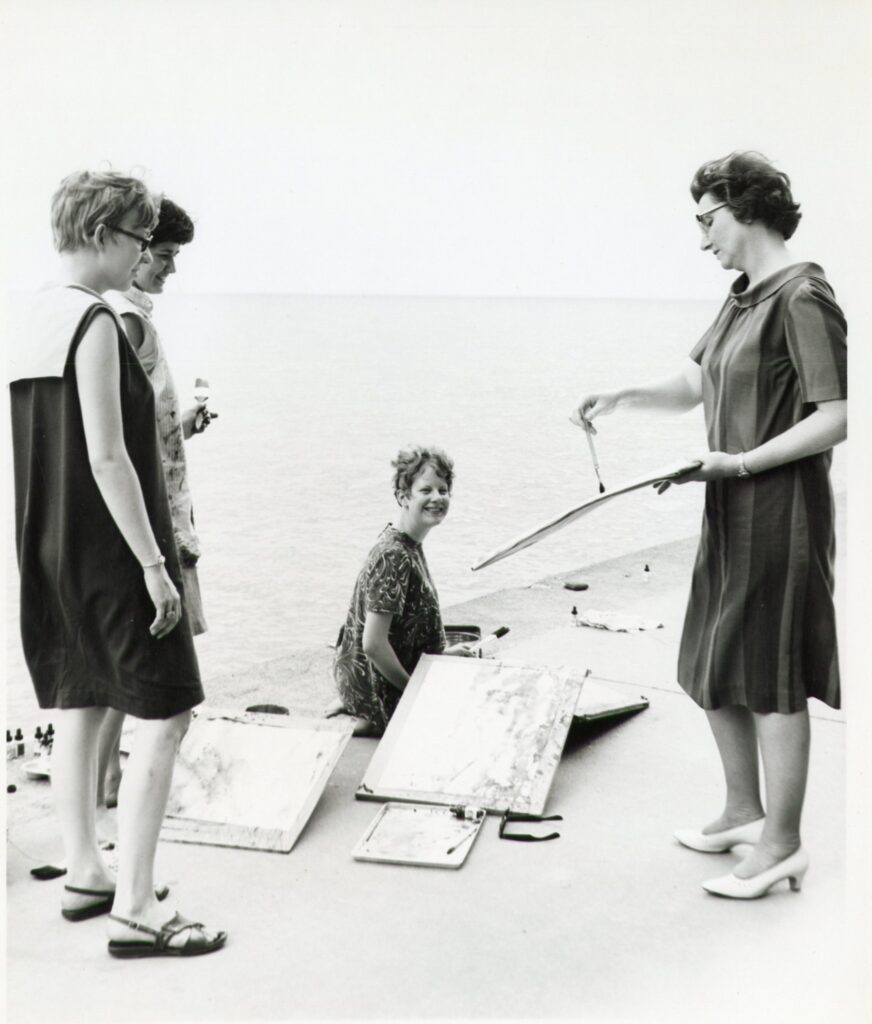
Sr. Blanche Marie Gallagher teaches a painting class on the shore of Lake Michigan.
For more information about Sr. Blanche Marie Gallagher’s rich legacy or to explore the lives of other Mundelein College alumni, visit the Women and Leadership Archives online collections.

Shannon is studying American and public history at Loyola University Chicago. Her research interests are in 20th-century American history, focusing on architecture, historic preservation, and memorial landscapes. In addition, she aspires to a career devoted to interpreting history for public audiences at cultural sites and institutions. Beyond her professional pursuits, Shannon enjoys playing the piano, strolling with her dog (Vesper), and partaking in Chicago’s rich culinary culture.
Images
Figure 1. Untitled, 5” x 7” photograph, 1974-1976, Women and Leadership Archives, Box 3, Folder 8: Post-Vatican II.
Figure 2. 1938: Art Department, June 1938, 8” x 10” photograph, Mundelein College Photograph Collection, https://luc.access.preservica.com/uncategorized/IO_669c7a9d-3539-419d-b4b7-77e3bcb3697e/.
Figure 3. 1931: Buildings: Campus View Winter, 1931, 8” x 10” photograph, Mundelein College Photograph Collection, https://luc.access.preservica.com/uncategorized/IO_84abf169-6841-45a8-ab87-c15ae7fb226d/.
Figure 4. 1944: Blood Drive, 1944, 8” x 11” photograph, Mundelein College Photograph Collection, https://luc.access.preservica.com/uncategorized/IO_62391dbc-d1e9-4e02-bfa5-51afe761d68c/.
Figure 5. 1965: Sr. Blanche Marie Gallagher, BVM, 1965, 3” x 5” photograph, Mundelein College Photograph Collection, https://luc.access.preservica.com/uncategorized/IO_22c5177c-558c-405b-9872-982869db23f2/.
Figure 6. Homage to Teilhard: Christogenesis, 3” x 5” notecard, Women and Leadership Archives, Box 1, Folder 15: Cards Designed by Gallagher.
Figure 7. Homage to Teilhard: Planetization, 3” x 5” notecard, Women and Leadership Archives, Box 1, Folder 15: Cards Designed by Gallagher.
Figure 8. Untitled, 5” x 7” photograph, 1974-1976, Women and Leadership Archives, Box 3, Folder 8: Post-Vatican II.
Loyola University Chicago’s Women and Leadership Archives Blog is designed to provide a positive environment for the Loyola community to discuss important issues and ideas. Differences of opinion are encouraged. We invite comments in response to posts and ask that you write in a civil and respectful manner. All comments will be screened for tone and content and must include the first and last name of the author and a valid email address. The appearance of comments on the blog does not imply the University’s endorsement or acceptance of views expressed. Questions? Please contact the WLA at wlarchives@LUC.edu.
